
Samuel Pepys was an English diarist and naval administrator. He served as administrator of the Navy of England and Member of Parliament and is most famous for the diary he kept for a decade while still a young man. Pepys had no maritime experience, but he rose to be the Chief Secretary to the Admiralty under both King Charles II and King James II through patronage, diligence, and his talent for administration. His influence and reforms at the Admiralty were important in the early professionalisation of the Royal Navy.

The Raid on the Medway, during the Second Anglo-Dutch War in June 1667, was a successful attack conducted by the Dutch navy on English warships laid up in the fleet anchorages off Chatham Dockyard and Gillingham in the county of Kent. At the time, the fortress of Upnor Castle and a barrier chain called the "Gillingham Line" were supposed to protect the English ships.

Sir William Penn was an English admiral and politician who sat in the House of Commons from 1660 to 1670. He was the father of William Penn, founder of the Province of Pennsylvania.

Royal Charles was an 80-gun first-rate three-decker ship of the line of the English Navy. She was built by Peter Pett and launched at Woolwich Dockyard in 1655, for the navy of the Commonwealth of England. She was originally called Naseby, named in honour of Sir Thomas Fairfax's decisive 1645 victory over the Royalist forces during the English Civil Wars. She was ordered in 1654 as one of a programme of four second rates, intended to carry 60 guns each. However, she was altered during construction to mount a complete battery of guns along the upper deck, and so was reclassed as a first rate.

The Pepys Library of Magdalene College, Cambridge, is the personal library collected by Samuel Pepys which he bequeathed to the college following his death in 1703.
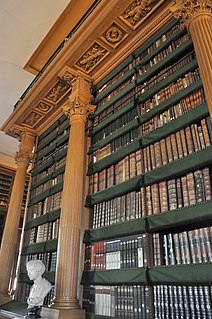
A bookcase, or bookshelf, is a piece of furniture with horizontal shelves, often in a cabinet, used to store books or other printed materials. Bookcases are used in private homes, public and university libraries, offices and bookstores. Bookcases range from small, low models the height of a table to high models reaching up to ceiling height. Shelves may be fixed or adjustable to different positions in the case. In rooms entirely devoted to the storage of books, such as libraries, they may be permanently fixed to the walls and/or floor.
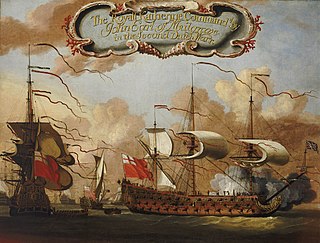
HMS Royal Katherine was an 84-gun second-rate ship of the line of the Royal Navy, launched in 1664 at Woolwich Dockyard. Her launching was conducted by Charles II and attended by Samuel Pepys. Royal Katherine fought in the Second and Third Anglo-Dutch Wars and the War of the Grand Alliance before entering the dockyard at Portsmouth for rebuilding in 1702. She was upgraded to carry 90 guns and served in the War of the Spanish Succession during which she was renamed Ramillies in honour of John Churchill's victory at the Battle of Ramillies. She was rebuilt again in 1742–3 before serving as the flagship of the ill-fated Admiral John Byng in the Seven Years' War. Ramillies was wrecked at Bolt Tail near Hope Cove on 15 February 1760.
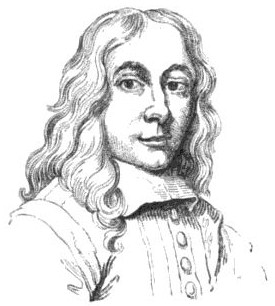
John Hayls, also Hailes (1600–1679), was an English Baroque-era portrait painter, principally known for his portrait of Samuel Pepys.

Elisabeth Pepys was the wife of Samuel Pepys, whom she married in 1655, shortly before her fifteenth birthday.

Chintz is a woodblock printed, painted, stained or glazed calico textile that originated in Golconda in the 16th century. The cloth is printed with designs featuring flowers and other patterns in different colours, typically on a light, plain background.

A butt joint is a technique in which two pieces of material are joined by simply placing their ends together without any special shaping. The name 'butt joint' comes from the way the material is joined together. The butt joint is the simplest joint to make since it merely involves cutting the material to the appropriate length and butting them together. It is also the weakest because unless some form of reinforcement is used, it relies upon glue or welding alone to hold it together. Because the orientation of the material usually presents only one end to a long gluing or welding surface, the resulting joint is inherently weak.
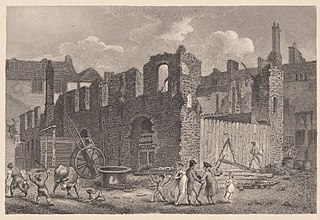
Gibbon's Tennis Court was a building off Vere Street and Clare Market, near Lincoln's Inn Fields in London, England. Originally built as a real tennis court, it was used as a playhouse from 1660 to 1663, shortly after the English Restoration. As a theatre, it has been variously called the "Theatre Royal, Vere Street", the "Vere Street Theatre", or simply "The Theatre". It was the first permanent home for Thomas Killigrew's King's Company and was the stage for some of the earliest appearances by professional actresses.
HMS Rupert was a 64-gun third rate ship of the line of the Royal Navy, ordered on 26 October 1664 as part of the ship construction programme of that year. She was launched on 26 January 1666 at Harwich Dockyard.

Sir Anthony Deane FRS (1633–1721) was a 17th-century mayor of Harwich, naval architect, Master Shipwright and commercial shipbuilder, and Member of Parliament.

HMS Edgar was a 72-gun third rate ship of the line of the Royal Navy, built by Baylie of Bristol and launched in 1668. The diarist and naval administrator Samuel Pepys visited the town during its construction, noting that in his opinion, "it will be a fine ship". By 1685 she was carrying 74 guns.
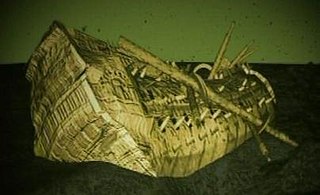
London was a 76-gun second-rate ship of the line in the Navy of the Commonwealth of England, originally built at Chatham Dockyard by shipwright John Taylor, and launched in June 1656. She gained fame as one of the ships that escorted Charles II from Holland back to England during the English Restoration, carrying Charles' younger brother James Duke of York, and commanded by Captain John Lawson.

William Hewer, sometimes known as Will Hewer, was one of Samuel Pepys' manservants, and later Pepys's clerk, before embarking on an administrative career of his own. Hewer is mentioned several times in Pepys' diary and was ultimately the executor of Pepys' will.
Deborah "Deb" Willet (1650–1678) was a young maid employed by Samuel Pepys (1633–1703), an English naval administrator and Member of Parliament. She and Pepys, 17 years her senior, engaged in a liaison that was chronicled in his famous diary. When Pepys's diary first was published in the late 19th century, the more explicit parts describing the author's affair with Willet were not printed. They only appeared in the most-recent version of the diary.

John Hilton was an English early Baroque composer. He is best known for his books Ayres or Fa-Las for Three Voices and Catch That Catch Can.
Kinsale Dockyard was a British Royal Navy base located at Kinsale, Ireland from c. 1647 to 1812.















